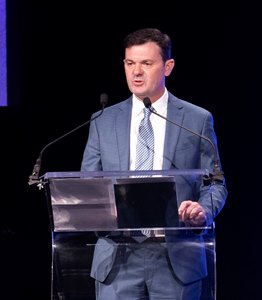What's Going On Here: Better Than Binoculars


The lasting impression of this year's Travers Stakes (G1) will be a pair of champions battling to the wire with Fierceness , champion 2-year-old male of 2023, finding just enough to hold off by a head sophomore filly Thorpedo Anna , who is certain to land divisional honors of her own this season.
While those action-packed final seconds of the Travers will fill the memory, we also enjoy scanning the charts of big race days to see what stands out. Such information is one of the joys of racing—specifically United States racing. We know Fierceness prevailed by a head because the Equibase chart posted not long after the 1 1/4-mile race says so.
And the talented callers from across the country fill those charts with footnotes that provide perspective. In this case, we're reminded that Fierceness "raced four paths off the rail past the stands the initial time before tucking three wide through the turn." We're reminded that Thorpedo Anna saved ground early as she "tracked the pace inside ... until tipped out to the two path with six furlongs to run ... angling three wide (at the five-sixteenths)."
But these days those charts are not the only postrace stop on the Equibase site. In 2024 the GPS charts at Equibase are a must-stop in turning a two-minute sporting event into 30 minutes of reliving the race from every possible angle. Also available soon after the race, these charts tell us that for Fierceness the race was 29 feet longer than for Thorpedo Anna thanks to the "cumulative distance traveled" selection from the dropdown that allows the viewer to tailor information.
On Travers day we watched Christophe Clement-trained Far Bridge post a front-running upset score over international rivals in the Sword Dancer Stakes (G1T), then we soon headed to the GPS chart where we saw the winner's time for each furlong of the race. With this information we observed that the son of English Channel was able to relax on the front end, running the fourth, fifth, and sixth furlongs all in 13 seconds or more for each eighth mile. The only time he posted a furlong under 12 seconds occurred in the 11th of the 12-furlong test when he put the race away with an 11.86 second move.
And as Idiomatic and Randomized dueled on the front end for the second time this year at Saratoga Race Course in the Aug. 23 Personal Ensign Stakes (G1), a postrace trip to the GPS chart revealed that Idiomatic needed only 105.6 strides to complete the first half-mile while her smaller rival Randomized (nearly all of Idiomatic's rivals are smaller!) needed 116.1 strides to complete that distance as she shadowed from the two path. As it would turn out, Idiomatic would win that battle—putting her rival away—but lose the war when Raging Sea rallied late.
The GPS charts provide winning times—and furlong times—for the winner and the also-rans. Idiomatic completed the 1 1/8-mile Personal Ensign in 1:49.17 while Raging Sea reached the wire in 1:49.14 after a final quarter mile in :25.07. Under previous charts, the Personal Ensign's runner-up time and Raging Sea's final quarter would have been estimates. Now we have the numbers.
Equibase currently offers GPS charts from some 30 tracks. Chart information is generated by GPS sensors placed on both sides of the saddle. They ping with a satellite 10 times a second while a base station at the track also receives information to provide a point of comparison. An algorithm then examines the information for any inconsistencies before putting the information forward.
Equibase president and COO Kyle McDoniel notes that a wealth of new information is now available compared with the days when a beam system provided information at points of call. Equibase continues to look at new possibilities for information and novel ways to present that data. Down the road the information could be used to generate graphics to provide a visualization of the race.
Further Review
While Equibase expands free information on its site, the New York racing stewards have blazed new ground in transparency.
In the "Stewards' Decisions" corner of the NYRA website, video interviews are providing insights into how officials make their decisions on interference calls. In the first video, steward Victor Escobar sits down with Laffit Pincay III to discuss recent interference calls at Saratoga. Just hearing Escobar provide reasons for stewards' decisions is informative but the video is especially compelling because Pincay is sharp enough to voice the questions that fans and horseplayers likely have about these calls.
And Escobar then directly answers those questions.
At BloodHorse we see this as a most-welcomed development.
This is the What's Going on Here column from the October issue of BloodHorse Magazine.
